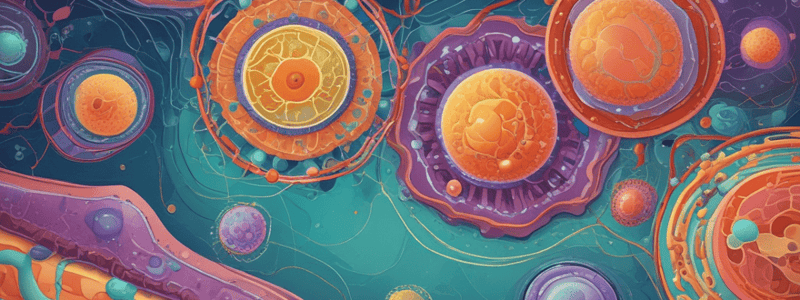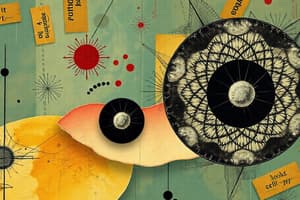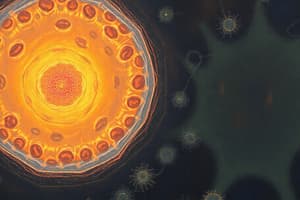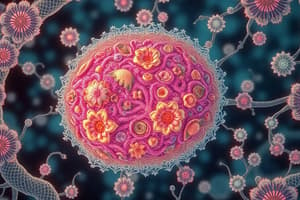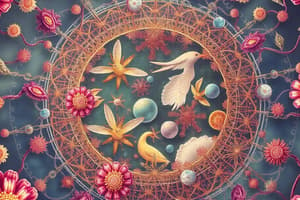Podcast
Questions and Answers
What does the cytoplasm of a cell refer to?
What does the cytoplasm of a cell refer to?
- The portion of the cell outside the nucleus (correct)
- The cell's genetic material
- The control center of the cell
- The boundary of the cell
Which part of the cell contains the genetic material in eukaryotic cells?
Which part of the cell contains the genetic material in eukaryotic cells?
- Nucleus (correct)
- Nucleolus
- Endoplasmic reticulum
- Cytoplasm
How can the organization of a cell best be compared?
How can the organization of a cell best be compared?
- To a quiet library
- To a chaotic marketplace
- To a streamlined vehicle
- To a modern factory (correct)
What major parts can a eukaryotic cell be divided into?
What major parts can a eukaryotic cell be divided into?
What term describes the structures within a cell that act like specialized organs?
What term describes the structures within a cell that act like specialized organs?
Why is understanding organelles important?
Why is understanding organelles important?
What is commonly referred to as the cytoplasm in a prokaryotic cell?
What is commonly referred to as the cytoplasm in a prokaryotic cell?
How does careful observation change one's perception of a factory or a cell?
How does careful observation change one's perception of a factory or a cell?
What role do ribosomes play in the cell?
What role do ribosomes play in the cell?
Which component of the cell is primarily involved in protein synthesis on its surface?
Which component of the cell is primarily involved in protein synthesis on its surface?
Which process occurs as newly assembled proteins enter the rough ER?
Which process occurs as newly assembled proteins enter the rough ER?
Where are proteins initially assembled within the cell?
Where are proteins initially assembled within the cell?
Where are proteins targeted for export to the cell membrane completed?
Where are proteins targeted for export to the cell membrane completed?
Which structure carries newly assembled proteins to the Golgi apparatus?
Which structure carries newly assembled proteins to the Golgi apparatus?
In what way is the rough endoplasmic reticulum distinguished from the smooth ER?
In what way is the rough endoplasmic reticulum distinguished from the smooth ER?
What is one of the primary functions of the endoplasmic reticulum?
What is one of the primary functions of the endoplasmic reticulum?
Which cellular structure is abundant in cells producing large amounts of protein for export?
Which cellular structure is abundant in cells producing large amounts of protein for export?
What type of proteins are made on the rough ER?
What type of proteins are made on the rough ER?
What is a primary function of the smooth endoplasmic reticulum?
What is a primary function of the smooth endoplasmic reticulum?
Where do proteins go after being produced in the rough ER?
Where do proteins go after being produced in the rough ER?
What structure modifies, sorts, and packages proteins and other materials from the endoplasmic reticulum?
What structure modifies, sorts, and packages proteins and other materials from the endoplasmic reticulum?
Which part of the endoplasmic reticulum is involved in lipid and steroid hormone synthesis?
Which part of the endoplasmic reticulum is involved in lipid and steroid hormone synthesis?
Which process does the Golgi apparatus NOT perform on proteins?
Which process does the Golgi apparatus NOT perform on proteins?
What kind of enzymes does the smooth endoplasmic reticulum contain?
What kind of enzymes does the smooth endoplasmic reticulum contain?
Which cell structures are directly involved in the movement of materials into and out of the nucleus?
Which cell structures are directly involved in the movement of materials into and out of the nucleus?
What is the primary function of chromatin when compared to chromosomes?
What is the primary function of chromatin when compared to chromosomes?
What is the function of the nucleolus within the nucleus?
What is the function of the nucleolus within the nucleus?
What is the analogy used to describe the function of organelles in a eukaryotic cell?
What is the analogy used to describe the function of organelles in a eukaryotic cell?
Why are eukaryotic cells uniquely described in the context of the nucleus?
Why are eukaryotic cells uniquely described in the context of the nucleus?
What type of membrane is the nuclear envelope described as?
What type of membrane is the nuclear envelope described as?
Which organelles are identified by the color 'tan' based on the chart?
Which organelles are identified by the color 'tan' based on the chart?
What happens to chromosomes during cell division?
What happens to chromosomes during cell division?
How many nucleoli are typically found within the nucleus as described?
How many nucleoli are typically found within the nucleus as described?
What is the role of the cell's cytoplasm as described in the analogy?
What is the role of the cell's cytoplasm as described in the analogy?
Which organelle is primarily responsible for capturing sunlight and converting it into chemical energy?
Which organelle is primarily responsible for capturing sunlight and converting it into chemical energy?
What surrounds chloroplasts?
What surrounds chloroplasts?
What pigment do chloroplasts contain that is essential for photosynthesis?
What pigment do chloroplasts contain that is essential for photosynthesis?
Which cells contain mitochondria?
Which cells contain mitochondria?
What is the primary function of mitochondria?
What is the primary function of mitochondria?
In addition to being surrounded by two membranes, what structural feature is significant in chloroplasts?
In addition to being surrounded by two membranes, what structural feature is significant in chloroplasts?
What type of protein is primarily found in microfilaments?
What type of protein is primarily found in microfilaments?
Which cytoskeletal component is essential for forming the spindle-shaped framework during animal cell division?
Which cytoskeletal component is essential for forming the spindle-shaped framework during animal cell division?
Which of the following structures is absent in plant cells but present in animal cells?
Which of the following structures is absent in plant cells but present in animal cells?
What is the arrangement pattern of microtubules in cilia and flagella?
What is the arrangement pattern of microtubules in cilia and flagella?
What is the primary function of microfilaments in amoeba?
What is the primary function of microfilaments in amoeba?
Which cytoskeletal component is involved in giving the cell its shape and organizing its parts?
Which cytoskeletal component is involved in giving the cell its shape and organizing its parts?
What protein are microtubules made from?
What protein are microtubules made from?
How do microfilaments provide support to the cell?
How do microfilaments provide support to the cell?
What is one of the main functions of a central vacuole in plant cells?
What is one of the main functions of a central vacuole in plant cells?
What role do lysosomes play in the cell?
What role do lysosomes play in the cell?
Which type of vacuole is primarily responsible for pumping excess water out of the cell?
Which type of vacuole is primarily responsible for pumping excess water out of the cell?
What is not a storage function of vacuoles?
What is not a storage function of vacuoles?
Why might a malfunction in lysosomes cause serious human diseases?
Why might a malfunction in lysosomes cause serious human diseases?
In what types of cells are lysosomes typically found?
In what types of cells are lysosomes typically found?
Vesicles are primarily involved in which cellular process?
Vesicles are primarily involved in which cellular process?
What primarily causes the pressure in a central vacuole of plant cells?
What primarily causes the pressure in a central vacuole of plant cells?
Which of the following is NOT a function of the cell wall?
Which of the following is NOT a function of the cell wall?
Which type of cells typically do NOT possess cell walls?
Which type of cells typically do NOT possess cell walls?
What characteristic of the cell membrane allows it to regulate the movement of materials?
What characteristic of the cell membrane allows it to regulate the movement of materials?
What is the primary structural component of the inner layer of large plant cell walls?
What is the primary structural component of the inner layer of large plant cell walls?
What feature allows older plant cell walls to become woody?
What feature allows older plant cell walls to become woody?
What is embedded within the lipid bilayer of nearly all cell membranes?
What is embedded within the lipid bilayer of nearly all cell membranes?
What creates the force that allows plant cell walls to grow in size?
What creates the force that allows plant cell walls to grow in size?
How do cell walls contribute to the shape of the cell?
How do cell walls contribute to the shape of the cell?
In humans, from which cell does the majority of mitochondria originate?
In humans, from which cell does the majority of mitochondria originate?
What theory did biologist Lynn Margulis propose concerning the origin of mitochondria and chloroplasts?
What theory did biologist Lynn Margulis propose concerning the origin of mitochondria and chloroplasts?
Which type of ancient cells are mitochondria and chloroplasts thought to have evolved from?
Which type of ancient cells are mitochondria and chloroplasts thought to have evolved from?
What is a consequence of genetic changes in human mitochondrial DNA?
What is a consequence of genetic changes in human mitochondrial DNA?
What disorder is associated with changes in mitochondrial DNA mentioned in the text?
What disorder is associated with changes in mitochondrial DNA mentioned in the text?
According to the endosymbiotic theory, which type of bacteria are thought to be the ancestors of chloroplasts?
According to the endosymbiotic theory, which type of bacteria are thought to be the ancestors of chloroplasts?
Which of the following best describes the primary structural difference between hydrophobic and hydrophilic ends of fatty acids?
Which of the following best describes the primary structural difference between hydrophobic and hydrophilic ends of fatty acids?
What is the principal reason for the formation of a lipid bilayer in aqueous solutions?
What is the principal reason for the formation of a lipid bilayer in aqueous solutions?
What structural feature allows the cell membrane to be described as a mosaic in the fluid mosaic model?
What structural feature allows the cell membrane to be described as a mosaic in the fluid mosaic model?
Which major property of the fluid mosaic model explains why the cell membrane is not rigid?
Which major property of the fluid mosaic model explains why the cell membrane is not rigid?
Which of the following statements best justifies the term 'fluid' in the fluid mosaic model?
Which of the following statements best justifies the term 'fluid' in the fluid mosaic model?
In the context of cell membranes, what does the term 'hydrophilic' specifically refer to?
In the context of cell membranes, what does the term 'hydrophilic' specifically refer to?
Which functional importance is served by the mosaic nature of cell membranes?
Which functional importance is served by the mosaic nature of cell membranes?
Which component of the cell membrane is primarily responsible for creating its hydrophobic core?
Which component of the cell membrane is primarily responsible for creating its hydrophobic core?
What is the role of carbohydrates attached to proteins in the cell membrane?
What is the role of carbohydrates attached to proteins in the cell membrane?
How do proteins and lipids in cell membranes contribute to its fluidity?
How do proteins and lipids in cell membranes contribute to its fluidity?
Flashcards are hidden until you start studying
Study Notes
Cell Organization
- A eukaryotic cell can be divided into two major parts: the nucleus and the cytoplasm.
- The nucleus contains a cell's genetic information and is surrounded by a nuclear envelope.
- The cytoplasm is the portion of the cell outside the nucleus and contains various organelles.
The Nucleus
- The nucleus is the control center of the cell.
- It is membrane-enclosed and contains DNA, which carries the cell's genetic instructions.
- The nucleus is surrounded by a nuclear envelope, which is a double membrane that allows materials to move into and out of the nucleus.
Organelles That Build Proteins
- Ribosomes are small particles of RNA and protein that assemble proteins in the cytoplasm.
- Proteins are assembled on ribosomes, which follow coded instructions from DNA.
- The rough endoplasmic reticulum (RER) is a system of flattened sacs and tubules that is involved in protein synthesis.
- The RER is covered with ribosomes and is responsible for modifying and packaging proteins.
The Golgi Apparatus
- The Golgi apparatus is a stack of flattened membranes that receives and modifies proteins from the RER.
- It is responsible for sorting and packaging proteins and other materials for storage or secretion.
- The Golgi apparatus is like a "distribution ship" where proteins are sorted and "tagged" for their final destinations.
Organelles That Store, Clean Up, and Support
- Vacuoles are large, membrane-bound structures that store water, salts, proteins, and carbohydrates.
- Lysosomes are small organelles that contain hydrolytic enzymes and are responsible for breaking down lipids, carbohydrates, and proteins.
- The cytoskeleton is a network of protein fibers that gives the cell its shape and helps to organize the cell's parts.
- It is composed of three types of protein filaments: microfilaments, microtubules, and intermediate filaments.
Microfilaments
- Microfilaments are thin, solid fibers that are composed of actin.
- They provide support and help to anchor the cell membrane.
- They are also involved in cell movement.
Microtubules
- Microtubules are hollow tubes that are made up of tubulin.
- In many cells, they help to maintain cell shape, but in animal cells, they are particularly important in cell division.
- They are organized into a rigid structure called a centriole.
Organelles That Capture and Release Energy
- Chloroplasts are organelles found in plants and some other organisms that capture energy from sunlight and convert it into chemical energy.
- Mitochondria are organelles found in nearly all eukaryotic cells that convert the chemical energy stored in food molecules into energy that can be used by the cell.
Cellular Boundaries
- Cell walls are outer coverings that provide protection, support, and function.
- They are found in many organisms, including bacteria, fungi, and plants.
- Cell membranes are thin layers of lipid and protein that surround the cell and regulate the movement of materials.
- They are composed of a lipid bilayer in which proteins and carbohydrates are embedded.
The Fluid Mosaic Model
- The fluid mosaic model describes the structure of cell membranes.
- It is composed of a lipid bilayer in which proteins and carbohydrates are embedded.
- The lipid bilayer is fluid and dynamic, allowing the proteins and carbohydrates to move within the membrane.### Cell Environment
- Cells need to maintain their internal environment to ensure proper functioning.
- Cells achieve this through various means, including regulating the concentration of ions, pH, and temperature.
Cell Membrane Structure and Function
- The cell membrane is composed of a bilayer of phospholipids with hydrophilic tails facing outwards and hydrophobic heads facing inwards.
- Embedded in the bilayer are proteins and carbohydrates, giving the cell membrane a fluid mosaic structure.
- The cell membrane's structure allows it to regulate the movement of substances in and out of the cell.
Cell Types and Structures
- Prokaryotic cells lack a true nucleus and membrane-bound organelles.
- Animal cells have a true nucleus and membrane-bound organelles.
- Both prokaryotic and animal cells have a cell membrane with a fluid mosaic structure.
Mitochondria and Chloroplasts
- Mitochondria are inherited solely from the cytoplasm of the ovum (egg cell) in humans.
- Mitochondria and chloroplasts contain their own genetic information in the form of small DNA molecules.
- The endosymbiotic theory proposes that mitochondria and chloroplasts originated from prokaryotic cells that lived independently and established a mutualistic relationship with eukaryotes over a billion years ago.
- Mitochondrial DNA changes can affect cell and body health, as seen in the case of LHON disorder.
Analogies
- Chloroplasts are like solar panels, converting light energy into chemical energy.
- Mitochondria are like electric power plants, generating energy for the cell through cellular respiration.
Studying That Suits You
Use AI to generate personalized quizzes and flashcards to suit your learning preferences.
